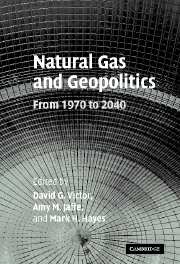Book contents
- Frontmatter
- Contents
- List of figures
- List of tables
- List of boxes
- List of contributors
- Foreword by James A. Baker, III
- Acknowledgments
- List of acronyms and abbreviations
- Part I Introduction and context
- Part II Historical case studies
- 2 Introduction to the historical case studies: research questions, methods and case selection
- 3 The Transmed and Maghreb projects: gas to Europe from North Africa
- 4 Liquefied natural gas from Indonesia: the Arun project
- 5 Bypassing Ukraine: exporting Russian gas to Poland and Germany
- 6 Natural gas pipelines in the Southern Cone
- 7 International gas trade in Central Asia: Turkmenistan, Iran, Russia, and Afghanistan
- 8 Liquefied natural gas from Qatar: the Qatargas project
- 9 Liquefied natural gas from Trinidad & Tobago: the Atlantic LNG project
- 10 Politics, markets, and the shift to gas: insights from the seven historical case studies
- Part III International gas trade economics
- Part IV Implications
- Appendix: Technical notes
- Index
- References
7 - International gas trade in Central Asia: Turkmenistan, Iran, Russia, and Afghanistan
Published online by Cambridge University Press: 22 September 2009
- Frontmatter
- Contents
- List of figures
- List of tables
- List of boxes
- List of contributors
- Foreword by James A. Baker, III
- Acknowledgments
- List of acronyms and abbreviations
- Part I Introduction and context
- Part II Historical case studies
- 2 Introduction to the historical case studies: research questions, methods and case selection
- 3 The Transmed and Maghreb projects: gas to Europe from North Africa
- 4 Liquefied natural gas from Indonesia: the Arun project
- 5 Bypassing Ukraine: exporting Russian gas to Poland and Germany
- 6 Natural gas pipelines in the Southern Cone
- 7 International gas trade in Central Asia: Turkmenistan, Iran, Russia, and Afghanistan
- 8 Liquefied natural gas from Qatar: the Qatargas project
- 9 Liquefied natural gas from Trinidad & Tobago: the Atlantic LNG project
- 10 Politics, markets, and the shift to gas: insights from the seven historical case studies
- Part III International gas trade economics
- Part IV Implications
- Appendix: Technical notes
- Index
- References
Summary
Introduction
This chapter describes how the landlocked energy-rich state of Turkmenistan has failed to successfully develop its vast gas reserves because of a combination of incompetent leadership, an unattractive investment climate, and competing geopolitical goals of the United States and Russia, which compounded the difficulties caused by a lingering civil war just beyond Turkmenistan's borders.
When Turkmenistan became an independent country in 1991, its President, Saparmurad Niyazov, had little preparation for the tasks that he faced. A senior Communist Party functionary, Niyazov became president of the Turkmen Soviet Socialist Republic on October 27, 1990, and was then elected to the post on June 21, 1991. In January 1994, Niyazov prolonged his rule until 2002, and on December 28, 1999 he was named President for life. The Turkmen leader likens himself to Atatürk, taking the name Turkmenbashi in 1993, but his rule is more analogous to Josef Stalin's. Niyazov's face is broadcast constantly on state television, his picture put on the front page of newspapers and on posters at principal intersections of the country's roadways. There is even a 12 meter gold-plated statue of Niyazov that is solar-driven to cast his countenance on much of downtown Ashgabat. He is the country's political and spiritual leader, the self-proclaimed author of Rukhname – part history, part biography, part spiritual guide, which is studied one day a week in Turkmenistan's schools.
- Type
- Chapter
- Information
- Natural Gas and GeopoliticsFrom 1970 to 2040, pp. 202 - 233Publisher: Cambridge University PressPrint publication year: 2006
References
- 6
- Cited by



